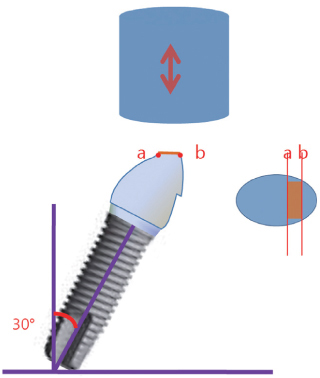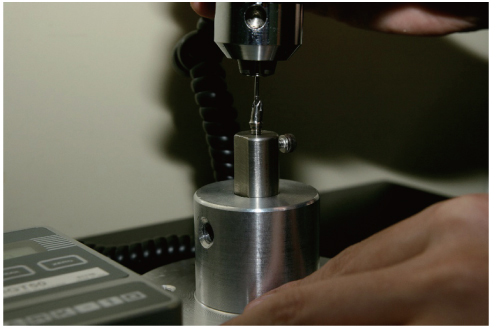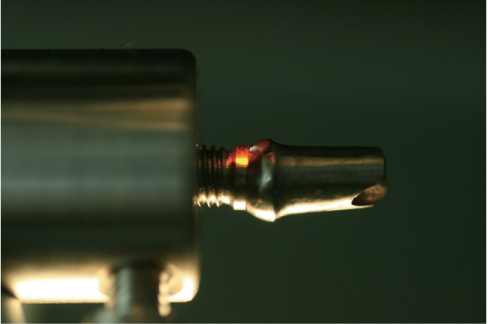J Adv Prosthodont.
2014 Feb;6(1):46-52. 10.4047/jap.2014.6.1.46.
A comparative study of gold UCLA-type and CAD/CAM titanium implant abutments
- Affiliations
-
- 1Department of Dentistry, School of Medicine, Ewha Womans University, Seoul, Republic of Korea. prosth@ewha.ac.kr
- 2Department of Prosthodontics, School of Dentistry, Seoul National University, Seoul, Republic of Korea.
- KMID: 2176570
- DOI: http://doi.org/10.4047/jap.2014.6.1.46
Abstract
- PURPOSE
The aim of this study was to evaluate the interface accuracy of computer-assisted designed and manufactured (CAD/CAM) titanium abutments and implant fixture compared to gold-cast UCLA abutments.
MATERIALS AND METHODS
An external connection implant system (Mark III, n=10) and an internal connection implant system (Replace Select, n=10) were used, 5 of each group were connected to milled titanium abutment and the rest were connected to the gold-cast UCLA abutments. The implant fixture and abutment were tightened to torque of 35 Ncm using a digital torque gauge, and initial detorque values were measured 10 minutes after tightening. To mimic the mastication, a cyclic loading was applied at 14 Hz for one million cycles, with the stress amplitude range being within 0 N to 100 N. After the cyclic loading, detorque values were measured again. The fixture-abutment gaps were measured under a microscope and recorded with an accuracy of +/-0.1 microm at 50 points.
RESULTS
Initial detorque values of milled abutment were significantly higher than those of cast abutment (P<.05). Detorque values after one million dynamic cyclic loadings were not significantly different (P>.05). After cyclic loading, detorque values of cast abutment increased, but those of milled abutment decreased (P<.05). There was no significant difference of gap dimension between the milled abutment group and the cast abutment group after cyclic loading.
CONCLUSION
In conclusion, CAD/CAM milled titanium abutment can be fabricated with sufficient accuracy to permit screw joint stability between abutment and fixture comparable to that of the traditional gold cast UCLA abutment.
Keyword
Figure
Reference
-
1. Duret F, Blouin JL, Duret B. CAD-CAM in dentistry. J Am Dent Assoc. 1988; 117:715–720.2. Priest G. Virtual-designed and computer-milled implant abutments. J Oral Maxillofac Surg. 2005; 63:22–32.3. Calamia JR. Advances in computer-aided design and computer-aided manufacture technology. J Philipp Dent Assoc. 1996; 48:31–40.4. Duke ES. The status of CAD/CAM in restorative dentistry. Compend Contin Educ Dent. 2001; 22:968–972.5. Grossmann Y, Pasciuta M, Finger IM. A novel technique using a coded healing abutment for the fabrication of a CAD/CAM titanium abutment for an implant-supported restoration. J Prosthet Dent. 2006; 95:258–261.6. Wiskott HW, Belser UC, Scherrer SS. The effect of film thickness and surface texture on the resistance of cemented extracoronal restorations to lateral fatigue loading. Int J Prosthodont. 1999; 12:255–262.7. Binon PP. Evaluation of machining accuracy and consistency of selected implants, standard abutments, and laboratory analogs. Int J Prosthodont. 1995; 8:162–178.8. Binon PP, McHugh MJ. The effect of eliminating implant/abutment rotational misfit on screw joint stability. Int J Prosthodont. 1996; 9:511–519.9. Cibirka RM, Nelson SK, Lang BR, Rueggeberg FA. Examination of the implant-abutment interface after fatigue testing. J Prosthet Dent. 2001; 85:268–275.10. Jörnéus L, Jemt T, Carlsson L. Loads and designs of screw joints for single crowns supported by osseointegrated implants. Int J Oral Maxillofac Implants. 1992; 7:353–359.11. McGlumphy EA, Mendel DA, Holloway JA. Implant screw mechanics. Dent Clin North Am. 1998; 42:71–89.12. Haack JE, Sakaguchi RL, Sun T, Coffey JP. Elongation and preload stress in dental implant abutment screws. Int J Oral Maxillofac Implants. 1995; 10:529–536.13. Martin WC, Woody RD, Miller BH, Miller AW. Implant abutment screw rotations and preloads for four different screw materials and surfaces. J Prosthet Dent. 2001; 86:24–32.14. Byrne D, Houston F, Cleary R, Claffey N. The fit of cast and premachined implant abutments. J Prosthet Dent. 1998; 80:184–192.15. Coelho AL, Suzuki M, Dibart S, DA Silva N, Coelho PG. Cross-sectional analysis of the implant-abutment interface. J Oral Rehabil. 2007; 34:508–516.16. Groten M, Girthofer S, Pröbster L. Marginal fit consistency of copy-milled all-ceramic crowns during fabrication by light and scanning electron microscopic analysis in vitro. J Oral Rehabil. 1997; 24:871–881.17. Groten M, Axmann D, Pröbster L, Weber H. Determination of the minimum number of marginal gap measurements required for practical in-vitro testing. J Prosthet Dent. 2000; 83:40–49.18. Sorensen JA. A standardized method for determination of crown margin fidelity. J Prosthet Dent. 1990; 64:18–24.19. Anusavice KJ, Carroll JE. Effect of incompatibility stress on the fit of metal-ceramic crowns. J Dent Res. 1987; 66:1341–1345.20. Rinke S, Hüls A, Jahn L. Marginal accuracy and fracture strength of conventional and copy-milled all-ceramic crowns. Int J Prosthodont. 1995; 8:303–310.21. Yeo IS, Yang JH, Lee JB. In vitro marginal fit of three all-ceramic crown systems. J Prosthet Dent. 2003; 90:459–464.22. Richter EJ. In vivo vertical forces on implants. Int J Oral Maxillofac Implants. 1995; 10:99–108.23. Sakaguchi RL, Douglas WH, DeLong R, Pintado MR. The wear of a posterior composite in an artificial mouth: a clinical correlation. Dent Mater. 1986; 2:235–240.24. Hakimeh S, Vaidyanathan J, Houpt ML, Vaidyanathan TK, Von Hagen S. Microleakage of compomer class V restorations: effect of load cycling, thermal cycling, and cavity shape differences. J Prosthet Dent. 2000; 83:194–203.25. Lewis S, Beumer J 3rd, Hornburg W, Moy P. The "UCLA" abutment. Int J Oral Maxillofac Implants. 1988; 3:183–189.26. Quek HC, Tan KB, Nicholls JI. Load fatigue performance of four implant-abutment interface designs: effect of torque level and implant system. Int J Oral Maxillofac Implants. 2008; 23:253–262.27. Steinebrunner L, Wolfart S, Ludwig K, Kern M. Implant-abutment interface design affects fatigue and fracture strength of implants. Clin Oral Implants Res. 2008; 19:1276–1284.28. Pyzdek T. Quality engineering handbook. In : Keller PA, editor. Planning, controlling, and assuring product and process quality. 2nd ed. New York: Marcel Dekker;2003. p. 226–230.29. Kalpakjian S. Manufacturing engineering and technology. In : Schmid S, editor. Cold welding and roll bonding. 5th ed. Upper Saddle River, NJ: Pearson/Prentice Hall;2006. p. 981.30. Sutter F, Weber HP, Sorensen J, Belser U. The new restorative concept of the ITI dental implant system: design and engineering. Int J Periodont Res Dent. 1993; 13:409–431.31. Norton MR. An in vitro evaluation of the strength of an internal conical interface compared to a butt joint interface in implant design. Clin Oral Implants Res. 1997; 8:290–298.
- Full Text Links
- Actions
-
Cited
- CITED
-
- Close
- Share
- Similar articles
-
- Considerations for Fabrication of CAD-CAM Abutments: Part I. Selection of Titanium Block and Fabrication Process
- Effect of casting procedure on screw loosening of UCLA abutment in two implant-abutment connection systems
- Mechanical Complications of Posterior Implant Restorations using CAD/CAM Titanium Customized Abutments: A Retrospective Study
- Zirconia ceramic fixed dental prosthesis with all-on-4 concept implants for irradiated maxilla: A case report
- Submucosal zirconia implant prosthesis fabricated with CAD/CAM








